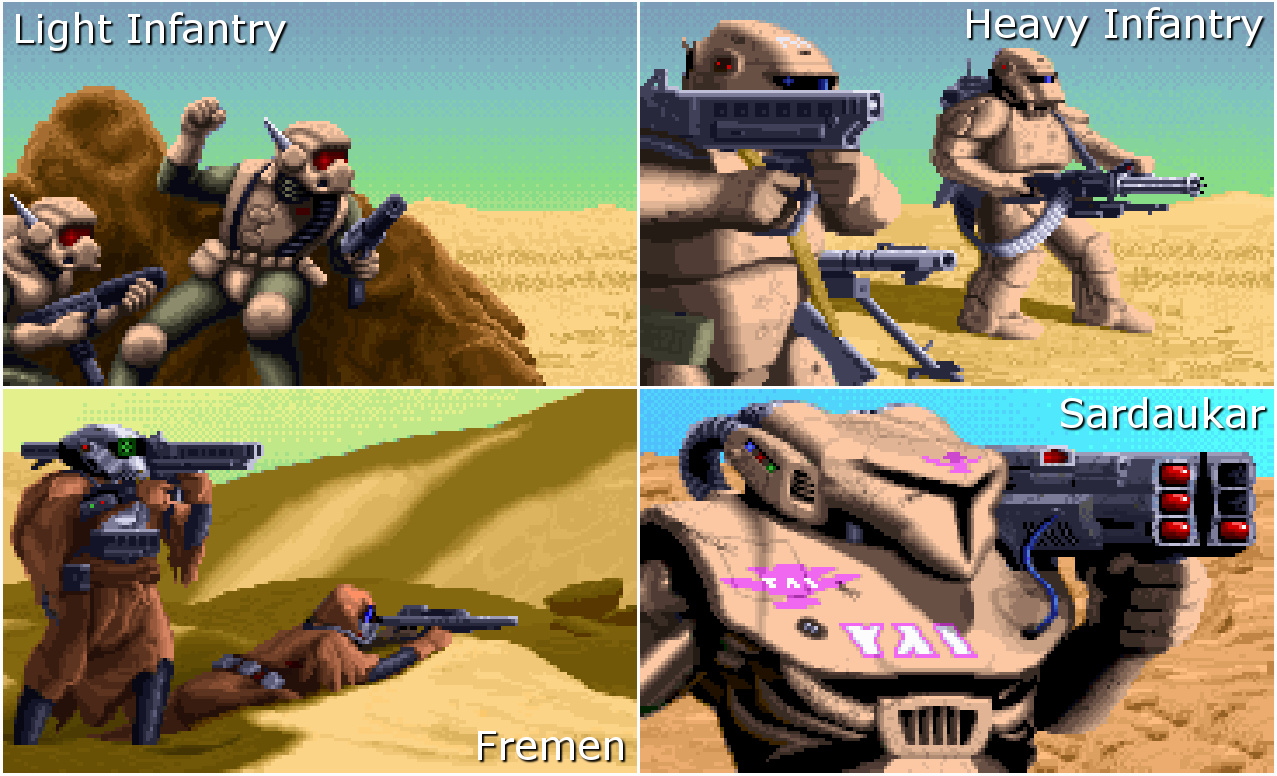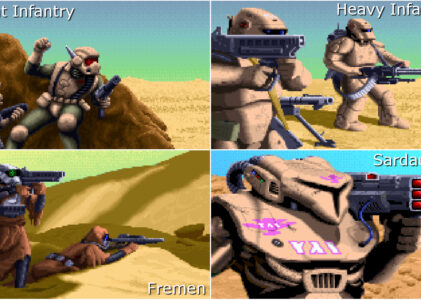Unveiling the Legacy of Dune II: Battle for Arrakis
In the realm of real-time strategy (RTS) gaming, few titles can claim the legendary status of Dune II: Battle for Arrakis. Released in the early 90s, this groundbreaking game not only defined the RTS genre but also set the stage for countless future titles. In this extensive exploration, we’ll delve into the genre, platforms, gameplay, key features, strategies, cheats, reviews, cultural impact, sequels, and similar games associated with Dune II: Battle for Arrakis.
The Birth of a Genre: Real-Time Strategy
Before we embark on our journey into the world of Dune II, let’s first grasp the essence of the real-time strategy genre.
Defining Real-Time Strategy
Real-time strategy games are a subgenre of strategy video games that emphasize quick decision-making and real-time tactical and strategic maneuvering. Players typically control armies, bases, or civilizations, striving to outwit their opponents through resource management, troop deployment, and strategic planning. Unlike turn-based strategy games, where players take turns making decisions, RTS games unfold in real-time, requiring players to think on their feet and react swiftly to changing circumstances.
Dune II: Battle for Arrakis – A Genre Pioneer
Dune II: Battle for Arrakis, commonly known as Dune II, stands as a pioneering force in the real-time strategy genre. Developed by Westwood Studios and released in 1992, this game broke new ground in gaming innovation and laid the foundation for the future of the RTS genre.

Platforms and Release
Dune II was initially released for MS-DOS, a popular operating system of the time. Its success led to subsequent releases on platforms like Amiga, Sega Genesis, and even a modified version for the Super Nintendo Entertainment System (SNES). The game’s multi-platform presence ensured that a wide range of gamers could experience its immersive world and strategic gameplay.
Gameplay: A Journey to Arrakis
Now that we’ve set the stage, let’s dive into the heart of Dune II’s gameplay, exploring the mechanics that captivated players and critics alike.
The Dune Universe
Dune II is set in the expansive and intriguing universe of Frank Herbert’s Dune series, a blend of science fiction and political intrigue. Players assume the role of one of the three noble houses: House Atreides, House Harkonnen, or House Ordos. Each faction boasts unique units, strengths, and weaknesses, adding depth to the gameplay experience.
Resource Management
Resource management is a core aspect of Dune II’s gameplay. Players must collect spice, the invaluable resource on the desert planet of Arrakis, to fund their operations. Spice is harvested by constructing harvesters and deploying them across spice fields. These resources are then used to build structures, train units, and research technologies, all vital for achieving victory.
Base Building
Base building is a fundamental component of Dune II’s gameplay. Players must construct their bases strategically, deciding on the placement of structures, defenses, and power generators. The layout of the base directly impacts its defensive capabilities and efficiency in resource collection.

Tactical Combat
Dune II excels in tactical combat. Players command armies consisting of various units, each with unique abilities and roles. Engagements require careful consideration of unit types, terrain, and formations. The game’s real-time nature demands quick thinking and adaptability during battles.
Key Gameplay Features
Dune II introduced several innovative gameplay features that became staples in the RTS genre.
Fog of War
Dune II implemented the “fog of war” mechanic, concealing unexplored areas of the map from the player. This feature added an element of uncertainty, forcing players to scout and strategize effectively.
Unit Special Abilities
Each unit in Dune II possessed special abilities, enhancing their versatility in combat. For instance, the Sonic Tank could create destructive shockwaves, while the Devastator Tank launched devastating long-range missiles.
Evolving Storyline
The game featured an evolving storyline, influenced by the player’s choices and successes. This dynamic narrative element added depth and replayability.
Strategies and Cheats: Navigating the Sands of Arrakis
Success in Dune II required not only a deep understanding of its mechanics but also clever strategies. Here are some effective tactics that players employed:
Spice Harvesting Efficiency
Efficient spice harvesting is crucial. Placing harvesters close to spice fields and optimizing their routes ensures a steady income of resources.

Base Defense
Strategically positioning turrets, walls, and units around the base can repel enemy attacks effectively. Investing in base defense early in the game is often a wise choice.
Unit Combinations
Combining different unit types in your armies can be devastating. For example, pairing fast-moving Trikes with long-range rocket-firing units like Siege Tanks can be a formidable force.
Resource Denial
Controlling spice fields near the enemy’s base can cut off their resource supply, hampering their ability to produce units and wage war.
The Power of the Sandworm
Utilizing sandworms, the massive creatures native to Arrakis, can be a game-changer. Luring them towards enemy units or bases can create chaos and disrupt their strategies.
Cheats for the Bold
Dune II had its fair share of cheats, known to veteran players. “MAKE IT SO,” “NO MORE SPICE,” and “DEATH HAND” were among the cheat codes that altered the game’s dynamics, providing a unique experience for those looking to experiment or overcome challenging missions.
Reviews and Cultural Impact
Dune II: Battle for Arrakis received widespread acclaim upon its release and left an indelible mark on the gaming industry.
Critical Acclaim
The game garnered critical praise for its innovative gameplay, engaging storyline, and strategic depth. It was lauded as a pioneer in the RTS genre and received high scores from gaming publications of the time.
Cultural Impact
Dune II’s influence extended beyond the gaming world. Its success played a pivotal role in popularizing the real-time strategy genre, paving the way for iconic franchises like Command & Conquer and StarCraft. The concept of controlling armies and managing resources in real-time became a cornerstone of modern gaming.
Legacy
The legacy of Dune II lives on through its spiritual successors and adaptations, such as “Emperor: Battle for Dune” and “Dune 2000.” These titles continued to explore the rich Dune universe and real-time strategy gameplay.
Sequels and Similar Games
The success of Dune II led to a series of sequels and inspired numerous similar games in the real-time strategy genre.
Dune II Sequels
Following the success of Dune II, Westwood Studios developed “Dune 2000” in 1998, a remake of the original game with updated graphics and gameplay improvements. Additionally, “Emperor: Battle for Dune” was released in 2001, expanding upon the Dune universe and introducing new gameplay mechanics.

Similar Games
Dune II’s influence is evident in several other real-time strategy titles:
Command & Conquer Series
Developed by Westwood Studios, the Command & Conquer series drew heavily from the success of Dune II. It became one of the most iconic RTS franchises, with a focus on fast-paced gameplay and diverse factions.
Warcraft Series
Blizzard Entertainment’s Warcraft series, beginning with “Warcraft: Orcs & Humans,” was heavily influenced by Dune II. It introduced the concept of heroes and played a significant role in shaping the fantasy-themed RTS genre.
StarCraft Series
Blizzard’s StarCraft series elevated the RTS genre to new heights, featuring three distinct factions, each with unique units and strategies. Its competitive multiplayer scene became legendary.
Age of Empires Series
Microsoft’s Age of Empires series blended historical settings with real-time strategy, offering players the chance to guide civilizations through the ages.
In Conclusion
Dune II: Battle for Arrakis, with its pioneering real-time strategy gameplay, innovative features, and immersive Dune universe, remains a pivotal title in the history of gaming. Its legacy endures through its sequels, the evolution of the real-time strategy genre, and the countless games it inspired. Whether you’re a seasoned commander or a newcomer to the sands of Arrakis, Dune II’s influence on gaming cannot be overstated, making it a timeless classic that continues to shape the world of strategy gaming.

